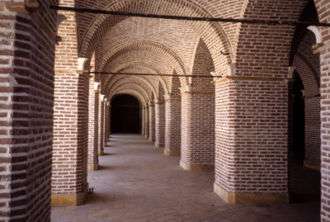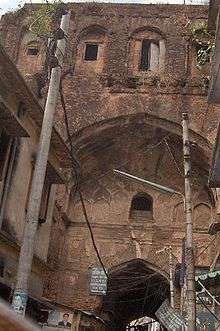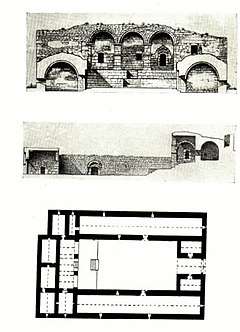Caravanserai

A caravanserai (/kærəˈvænsəri/;[1] was a roadside inn where travelers (caravaners) could rest and recover from the day's journey.[2] Caravanserais supported the flow of commerce, information, and people across the network of trade routes covering Asia, North Africa, and Southeast Europe, especially along the Silk Road.
These were found frequently along the Achaemenid Empire's Royal Road, a 2,500-kilometre-long (1,600 mi) ancient highway that stretched from Sardis to Susa according to Herodotus: "Now the true account of the road in question is the following: Royal stations exist along its whole length, and excellent caravanserais; and throughout, it traverses an inhabited tract, and is free from danger."[3] Major urban caravanserais were also built along the Grand Trunk Road in the Indian subcontinent, especially in the region of Mughal Delhi.
Etymology
| Look up caravanserai in Wiktionary, the free dictionary. |
Caravanserai

The word is also rendered as caravansary, caravansaray, caravanseray and caravansara. The Persian word کاروانسرای kārvānsarāy is a compound word combining kārvān "caravan" with sarāy "palace", "building with enclosed courts", to which the Persian suffix -yi is added. Here "caravan" means a group of traders, pilgrims, or other travelers, engaged in long distance travel. The word serai is sometimes used with the implication of caravanserai.
A number of place-names based on the word sarai have grown up: Mughal Serai, Sarai Alamgir and the Delhi Sarai Rohilla railway station for example, and a great many other places are also based on the original meaning of "palace".
Khan

The Persian caravanserai was built as a large road station, outside of towns. An inn built inside a town would be smaller[4] and was known in Persian as a khan (خان) (from Middle Persian hʾn' (xān, “house”)). In the Middle-East the term "khan" covers both meanings, of roadside inn as well as of inner-town inn. In Turkish the word is rendered as han. The same word was used in Bosnian, having arrived through Ottoman conquest. The Greek pandocheion, lit.: "welcoming all",[5] thus meaning 'inn', led to funduq in Arabic (فندق), pundak in Hebrew (פונדק), fundaco in Venice, fondaco in Genoa and alhóndiga[6] in Spanish.
Caravanserai in Arab literature
Al-Muqaddasi the Arab geographer wrote in 985 CE about the hostelries, or wayfarers' inns, in the Province of Palestine, a country at that time listed under the topography of Syria, saying: "Taxes are not heavy in Syria, with the exception of those levied on the Caravanserais (Fanduk); Here, however, the duties are oppressive..."[7] The reference here being to the imposts and duties charged by government officials on the importation of goods and merchandise, the importers of which and their beasts of burden usually stopping to take rest in these places. Guards were stationed at every gate to ensure that taxes for these goods be paid in full, while the revenues therefrom accruing to the Fatimid kingdom of Egypt.
Architecture

Most typically a caravanserai was a building with a square or rectangular walled exterior, with a single portal wide enough to permit large or heavily laden beasts such as camels to enter. The courtyard was almost always open to the sky, and the inside walls of the enclosure were outfitted with a number of identical animal stalls, bays, niches, or chambers to accommodate merchants and their servants, animals, and merchandise.[8]
Caravanserais provided water for human and animal consumption, washing, and ritual purification such as wudu and ghusl. Sometimes they had elaborate baths. They also kept fodder for animals and had shops for travelers where they could acquire new supplies. In addition, some shops bought goods from the traveling merchants.[9]
Notable caravanserais
- Garghabazar Caravanserai, Kharabakh, Azerbaijan
- Büyük Han
- Caravanserai of Sa'd al-Saltaneh
- Manuc's Inn, Bucharest, Romania.
- Khan al-Tujjar (Mount Tabor)
- Khan al-Tujjar (Nablus)
- Khan al-Umdan
- Khan As'ad Pasha
- Khan Jaqmaq
- Khan el-Khalili
- Khan Sulayman Pasha
- Khan Tuman
- Rabati Malik, Uzbekistan.
- Orbelian's Caravanserai, Armenia
- Nampally Sarai, Nampally, Hyderabad, India.
- Zeinodin Caravanserai, Zein-o-din, Yazd, Iran.
Gallery


 Fallujah's Caravanserai in use, ca. 1914
Fallujah's Caravanserai in use, ca. 1914 Inside the Orbelian's Caravanserai, Armenia
Inside the Orbelian's Caravanserai, Armenia Caravansara Sangi in Zanjan, Iran
Caravansara Sangi in Zanjan, Iran

 Abandoned caravansara in Neyestānak, Iran
Abandoned caravansara in Neyestānak, Iran
- Khan al-Wazir, Aleppo, Syria
 Sultan Han caravanserai.
Sultan Han caravanserai. Ruins of Bara Katra, or Great Caravanserai, in Dhaka, Bangladesh; built by the Mughal Prince Shah Shuja
Ruins of Bara Katra, or Great Caravanserai, in Dhaka, Bangladesh; built by the Mughal Prince Shah Shuja
 Ruins of the Shaista Khan caravanserai in Dhaka, Bangladesh; built by the Mughal viceroy Shaista Khan
Ruins of the Shaista Khan caravanserai in Dhaka, Bangladesh; built by the Mughal viceroy Shaista Khan Entrance to Anderkilla in Chittagong, Bangladesh
Entrance to Anderkilla in Chittagong, Bangladesh
See also
- Caravan city
- Islamic architecture
- Shaki Caravanserai, is a historical monument in Shaki Khanate, Azerbaijan
- Architecture of Azerbaijan
- Turkish architecture
- Persian architecture
- Persian gardens and bagh
- List of caravanserais
- List of caravanserais in Azerbaijan
- List of Seljuk hans and kervansarays in Turkey
- List of streets, hans and gates in Grand Bazaar, Istanbul
References
- ↑ "Dictionary.com – caravansary". Retrieved 31 Jan 2016.)
- ↑
 Chisholm, Hugh, ed. (1911). "Caravanserai". Encyclopædia Britannica (11th ed.). Cambridge University Press.
Chisholm, Hugh, ed. (1911). "Caravanserai". Encyclopædia Britannica (11th ed.). Cambridge University Press. - ↑ "The History - Herodotus" - http://classics.mit.edu/Herodotus/history.mb.txt
- ↑ http://www.britannica.com/EBchecked/topic/316248/khan
- ↑ http://biblehub.com/greek/3829.htm
- ↑ alhóndiga in the Diccionario de la Real Academia Española
- ↑ Mukaddasi, Description of Syria, Including Palestine, ed. Guy Le Strange, London 1886, pp. 91, 37
- ↑ Sims, Eleanor. 1978. Trade and Travel: Markets and Caravansary.' In: Michell, George. (ed.). 1978. Architecture of the Islamic World - Its History and Social Meaning. London: Thames and Hudson Ltd, 101.
- ↑ Ciolek, T. Matthew. 2004-present. Catalogue of Georeferenced Caravansaras/Khans Archived 2005-02-07 at the Wayback Machine.. Old World Trade Routes (OWTRAD) Project. Canberra: www.ciolek.com - Asia Pacific Research Online.
- ↑ Vladimir Braginskiy. Tourist Attractions in the USSR: A Guide. Raduga Publishers, 1982. 254 pages. Page 104.
The whole of the centre of Sheki has been proclaimed a reserve protected by the state. To take you back to the time of the caravans, two large eighteenth-century caravanserais have been preserved with spacious courtyards where the camels used to rest, cellars where goods were stored, and rooms for travellers.
Further reading
- Branning, Katharine. 2002. turkishhan.org, The Seljuk Han in Anatolia. New York, USA.
- Cytryn-Silverman, Katia. 2010. The Road Inns (Khans) in Bilad al-Sham. BAR (British Archaeological Reports), Oxford. ISBN 9781407306711
- Encyclopædia Iranica, p. 798-802
- Erdmann, Kurt, Erdmann, Hanna. 1961. Das anatolische Karavansaray des 13. Jahrhunderts, 3 vols. Berlin: Mann, 1976, ISBN 3-7861-2241-5
- Hillenbrand, Robert. 1994. Islamic Architecture: Form, function and meaning. NY: Columbia University Press. (see Chapter VI for an in depth overview of the caravanserai).
- Kiani, Mohammad Yusef. 1976. Caravansaries in Khorasan Road. Reprinted from: Traditions Architecturales en Iran, Tehran, No. 2 & 3, 1976.
- Schutyser, Tom. 2012. Caravanserai: Traces, Places, Dialogue in the Middle East. Milan: 5 Continents Editions, ISBN 978-88-7439-604-7
- Yavuz, Aysil Tükel. 1997. The Concepts that Shape Anatolian Seljuq Caravansara. In: Gülru Necipoglu (ed). 1997. Muqarnas XIV: An Annual on the Visual Culture of the Islamic World. Leiden: E. J. Brill, 80-95. [archnet.org/library/pubdownloader/pdf/8967/doc/DPC1304.pdf Available online as a PDF document, 1.98 MB]
External links
| Wikimedia Commons has media related to Caravanserais. |
- Shah Abbasi Caravanserai, Tishineh
- Caravansara Pictures
- Consideratcaravanserai.net, Texts and photos on research on caravanserais and travel journeys in Middle East and Central Asia.
- Caravanserais (Kervansaray) in Turkey
- The Seljuk Han in Anatolia


-Jerusalem-Temple_Mount-Dome_of_the_Rock_(SE_exposure).jpg)